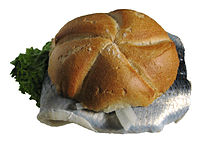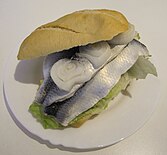Fischbrötchen: Difference between revisions
No edit summary |
→External links: cat / spelling |
||
| Line 41: | Line 41: | ||
* {{Commons category-inline|Fischbrötchen}} |
* {{Commons category-inline|Fischbrötchen}} |
||
{{ |
{{Sandwiches}} |
||
{{DEFAULTSORT:Fischbrotchen}} |
{{DEFAULTSORT:Fischbrotchen}} |
||
| Line 48: | Line 48: | ||
[[Category:North German cuisine]] |
[[Category:North German cuisine]] |
||
[[Category:Fish dishes]] |
[[Category:Fish dishes]] |
||
[[Category: |
[[Category:Seafood sandwiches]] |
||
[[Category:German sandwiches]] |
[[Category:German sandwiches]] |
||
[[Category:Pages translated from German Wikipedia]] |
[[Category:Pages translated from German Wikipedia]] |
||
Revision as of 20:56, 8 September 2020
 Fischbrötchen with pickled herring | |
| Type | Sandwich |
|---|---|
| Place of origin | Germany |
| Main ingredients | Bread, fish, onions; sometimes remoulade and pickles |
A Fischbrötchen () (pl. "Fischbrötchen", lit. fish bun) is a sandwich made with fish and other components such as fresh white or dried onions, pickles, remoulade, creamy horseradish sauce, ketchup, or cocktail sauce. It is commonly eaten in Northern Germany, due to the region's proximity to the North Sea and Baltic Sea.
A common preparation is made with bismarck herring or soused herring. Other varieties use Brathering, rollmops, European sprat, salmon, smoked Atlantic mackerel, fried Atlantic cod, and other fish varieties (e.g., fish burgers). Prawns are sometimes used, as are various other species of food fish. Fischbrötchen are commonly served at fast food stands or take-out restaurants.
The Hanover Fair was initially colloquially known as the "Fischbrötchen fair" due to the fish buns served there as a snack.[1]
Gallery
-
Fischbrötchen
-
A variety of Fischbrötchen, including with Rollmops
-
A collection of seafood sandwiches
-
A Fischbrötchen made with pickled herring and onion
See also
References
- ^ Am Anfang war das Fischbrötchen: Die Welt, 4 April 2005 (in German)
External links
 Media related to Fischbrötchen at Wikimedia Commons
Media related to Fischbrötchen at Wikimedia Commons




